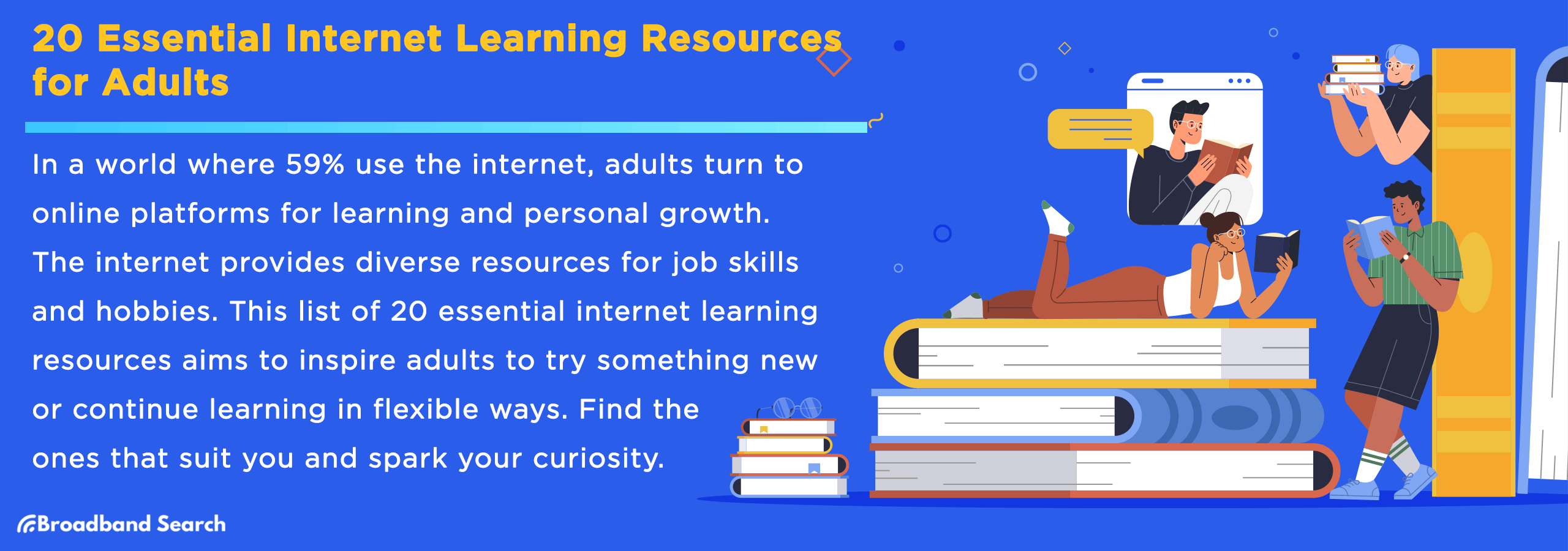In a world where 59 percent of the global population actively uses the internet, adults are increasingly turning to online platforms for learning and personal growth. The internet offers a vast array of resources tailored to adult learners, spanning various fields and interests. From enhancing job skills to pursuing new hobbies, these digital tools empower adults to continue their education in flexible and diverse ways.
And it’s hard to keep track of them all, or even know about them. The following list of 20 essential internet learning resources is curated to inspire you to either try something new or further your learning. It’s here to present high-quality, accessible, and varied platforms that cater to the unique learning styles and goals of adult learners.
Not every one will be for you, and that’s ok. Just look for the ones that you think will improve your life and spark your curiosity.
Online Universities and Higher Education Platforms
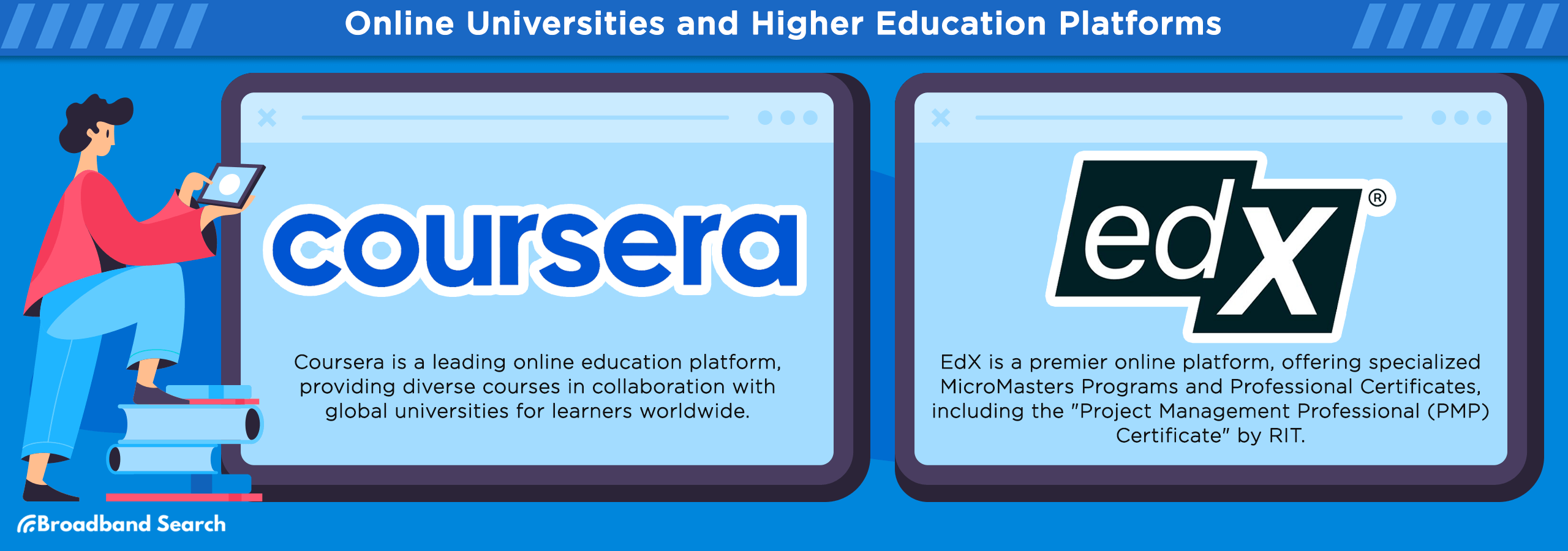
Coursera
Coursera stands out as a leader in online education, offering a unique blend of university-level courses, certificates, and degree programs. Its collaborations with top universities worldwide have democratized higher education, making it accessible to adult learners regardless of location, available time, and in many cases income.
Data Science
Coursera’s data science courses, led by experts from renowned institutions like Johns Hopkins University, cater to both beginners and advanced learners. A standout course is the Data Science Specialization, which equips you with essential skills like statistical analysis and machine learning to better adapt to an evolving economy.
Business
Whether you're aiming to climb the corporate ladder or start your own venture, Coursera’s business courses cover it all. The Wharton School of the University of Pennsylvania offers the popular Business Foundations Specialization. This program enhances your understanding of marketing, management, and financial acumen.
Personal Development
Personal development courses on Coursera, such as “The Science of Well-Being” from Yale University, focus on improving life skills and mental well-being. With stress management and productivity being pivotal in today’s fast-paced world, these courses are timely and beneficial for maintaining a healthy work-life balance.
edX
EdX is another renowned platform offering university-level courses across various disciplines.
MicroMasters Programs
These are specialized, graduate-level courses that provide you with in-depth knowledge in specific subjects. For instance, if you're interested in data science, you can pursue the MicroMasters program UC Berkeley offers.
Professional Certificates
EdX offers a diverse range of professional certificates. Consider the "Project Management Professional (PMP) Certificate" by RIT. Earning this certification can open doors to lucrative job opportunities, backed by the fact that PMP-certified professionals earn an average salary of $112,000, according to the latest statistics from PMI.
Wide Range of Disciplines
EdX collaborates with prestigious universities and institutions, such as Harvard, MIT, and Stanford, to bring you courses in areas like business, technology, health, and humanities. Whether you're interested in computer science or psychology, you'll find a course that suits your passion.
Specialized Skill Development Platforms
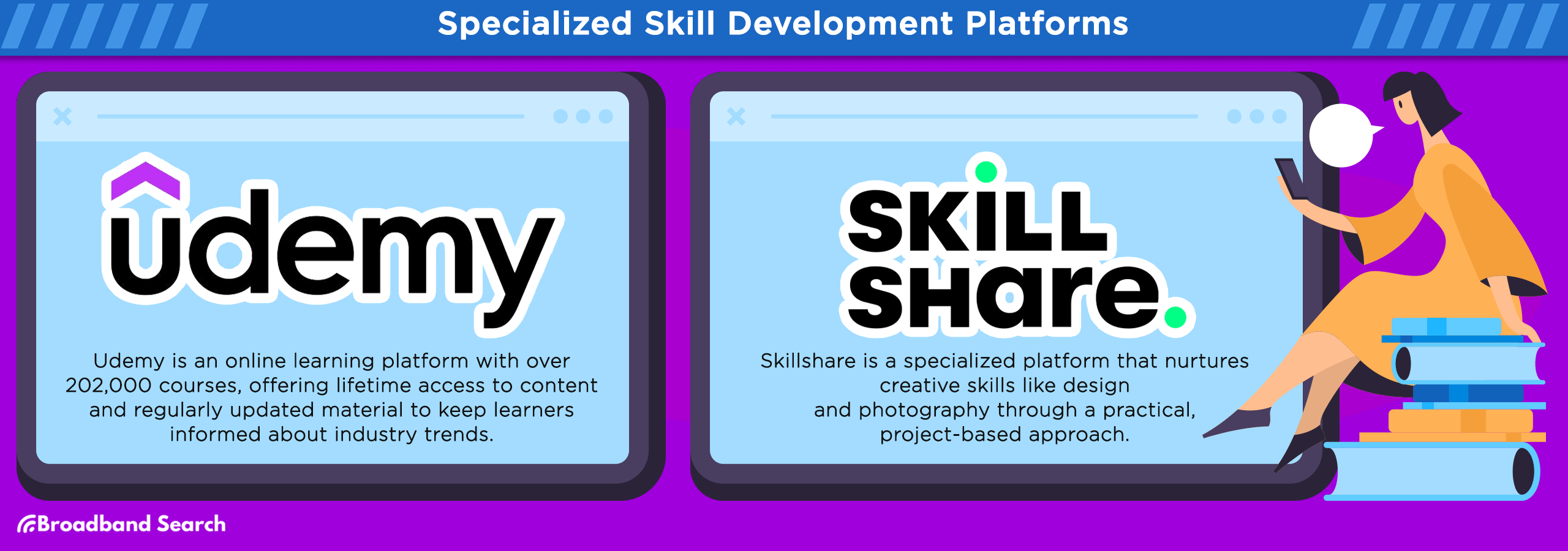
Udemy
Udemy is an online learning platform that offers a wide array of courses covering technical, business, and creative skills. Here's a closer look of the unique offerings of Udemy:
Lifetime Access
When you purchase a course on Udemy, you gain lifetime access to the content. This means you can revisit the materials and updates whenever you need them. For example, "The Complete Web Developer Course 3.0" by Rob Percival grants you lifetime access, allowing you to stay current with evolving web technologies.
Constantly Updated Content
Udemy courses are frequently updated to keep pace with industry trends. For example, the "Digital Marketing Masterclass" by Phil Ebiner is regularly refreshed to reflect the latest strategies and tools. This ensures that you're always learning the most relevant and up-to-date information.
Variety of Courses
With over 202,000 courses, Udemy offers an unparalleled diversity of subjects. This includes niche topics like drone piloting, which is gaining prominence with the commercial drone market expected to grow to $58.4 billion by 2026.
Skillshare
Skillshare distinguishes itself as a specialized platform focused on nurturing creative skills like design, photography, and writing. It stands out for its practical, project-based approach, making learning interactive and directly applicable to real-world scenarios.
Interactive Projects
Skillshare courses often include real-world projects, allowing learners to apply what they've learned. For example, a graphic design course might include a logo design project. The success of this practical approach is reflected in Skillshare's user statistics, with over 12 million learners and a high course completion rate.
Peer Feedback
One of Skillshare's unique features is the opportunity for learners to receive feedback from peers. This collaborative environment is particularly beneficial in creative fields like graphic design, where peer critiques can offer diverse perspectives and foster improvement. A study by Cornell University found that peer feedback enhances learning outcomes and student satisfaction.
Collaborative Learning
Skillshare offers collaborative classes where learners work together on projects. This collaborative environment can lead to valuable networking opportunities and the chance to co-create inspiring works. Joining forces with others can be a catalyst for creative growth.
Language Learning Tools
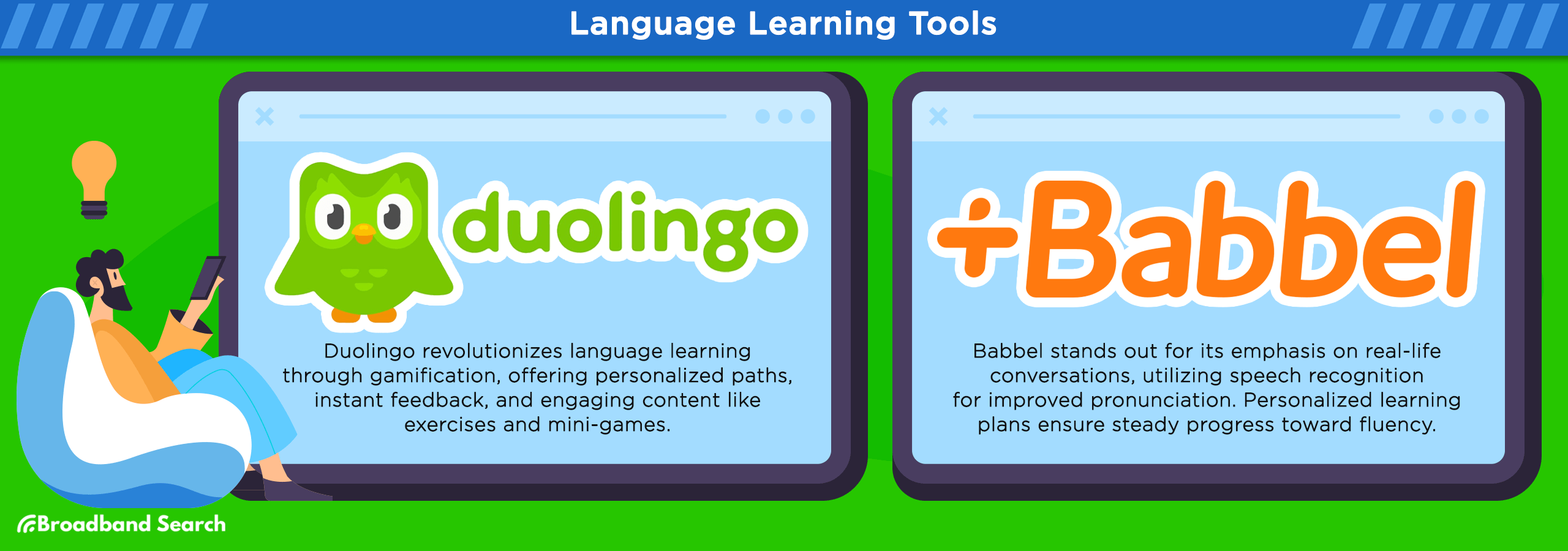
Duolingo
Duolingo revolutionizes language learning with its gamified approach, making the acquisition of a variety of languages both fun and effective. This method is pivotal in a globalized world where multilingualism is increasingly linked to better cognitive abilities and career opportunities.
Customized Learning Paths
Each user's journey on Duolingo is tailored to their learning speed and style. For instance, a beginner in Spanish will have a different path from someone more advanced, ensuring a personalized learning experience. Duolingo's effectiveness is evident, with 34 hours on the app equating to a full university semester of language education.
Immediate Feedback
Users receive instant feedback on their exercises, enabling quick learning and correction of mistakes. This feature is particularly beneficial in mastering pronunciation, as immediate correction can accelerate proficiency. Duolingo's real-time feedback mechanism has led to a 55 percent increase in user retention rates.
Engaging Content
Duolingo keeps users engaged with a variety of exercises and mini-games, making language learning less daunting and more enjoyable. This is crucial in maintaining long-term commitment, a factor often overlooked in traditional language learning methods. The app boasts over 500 million active users, a testament to its engaging and effective content.
Babbel
Babbel offers a unique approach to language learning that focuses on real-life conversations. If you've ever wished to master a new language for travel, work, or simply personal enrichment, Babbel has some special features that set it apart.
Speech Recognition Technology
Babbel incorporates cutting-edge speech recognition technology that helps you fine-tune your pronunciation. As you practice speaking, the system provides instant feedback to ensure you're on the right track. In fact, a study by Yale University found that 100 percent of Babbel users improved their oral efficiency within just three months.
Real-Life Dialogue Examples
Instead of dry vocabulary lists, Babbel immerses you in real-life dialogue examples. You'll learn how native speakers communicate in everyday situations, from ordering food in a restaurant to negotiating in business meetings. Babbel's content is designed to be practical and immediately applicable to real-world scenarios.
Personalized Learning Plans
Babbel tailors your learning journey to your specific needs and goals. Whether you're a beginner or looking to enhance your existing language skills, you can choose the level that suits you. With personalized lesson plans, users make steady progress toward fluency.
Coding and Technical Skills
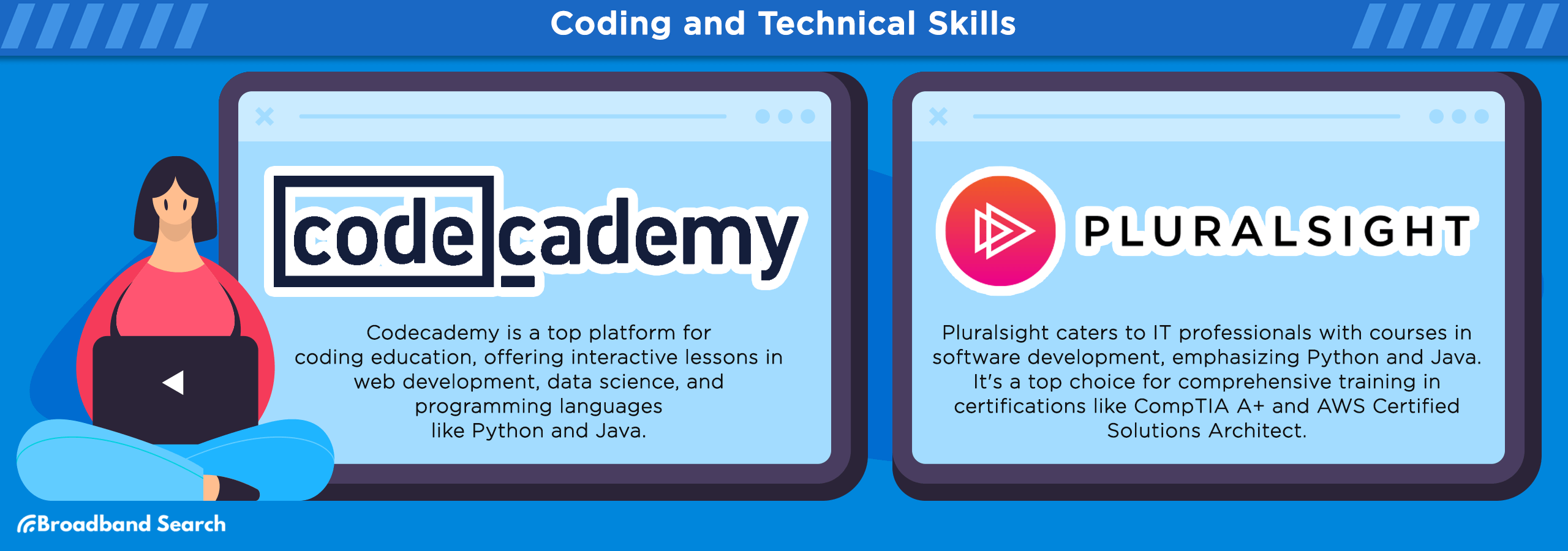
Codecademy
Codecademy stands as a beacon for those venturing into the coding world, offering interactive lessons that transform complex coding concepts into manageable, engaging learning experiences. Its hands-on approach is pivotal in a digital landscape where coding skills are increasingly indispensable. Some great courses on the platform include:
Web Development
Codecademy's web development courses cover everything from HTML and CSS to JavaScript and front-end frameworks like React. With hands-on projects and interactive coding challenges, you'll build your own websites and web applications. Considering that web development roles are expected to grow by 16 percent from 2022 to 2032, these skills are highly marketable.
Data Science
If you're drawn to the world of data analysis and machine learning, Codecademy's data science track is for you. You can learn Python, SQL, and data visualization techniques while working on real datasets. A study by Indeed found that data scientists with Python skills earn an average salary of $112,000.
Programming Languages
Codecademy offers comprehensive courses in popular programming languages, from Python and Java to Ruby and C++. These languages serve as the foundation for a wide array of software development careers. Java developers can earn an average salary of $103,000, as reported by Glassdoor, for one example.
Pluralsight
Pluralsight is designed primarily for IT professionals who aspire to stay at the forefront of the technology industry.
Software Development
Pluralsight offers an extensive range of courses in software development, covering programming languages like Python, Java, and C#. These courses empower IT professionals to enhance their coding skills and stay competitive in a rapidly evolving field. For instance, Python developers' salaries have seen a surge, with the average salary now standing at $120,000, according to recent data from Dice.
IT Certifications
Pluralsight is a go-to platform for IT certification preparation. Whether you're aiming to earn certifications like CompTIA A+, AWS Certified Solutions Architect, or Cisco CCNA, Pluralsight provides comprehensive training materials and practice exams. In fact, 92 percent of Pluralsight users report that their certifications have positively impacted their careers.
Cybersecurity Training
In the digital age, cybersecurity is paramount. Pluralsight equips IT professionals with the knowledge and skills needed to safeguard organizations against cyber threats. The demand for cybersecurity experts continues to rise, with the field expected to grow by 32 percent over the next decade, according to the U.S. Bureau of Labor Statistics.
Professional Development and Career Enhancement
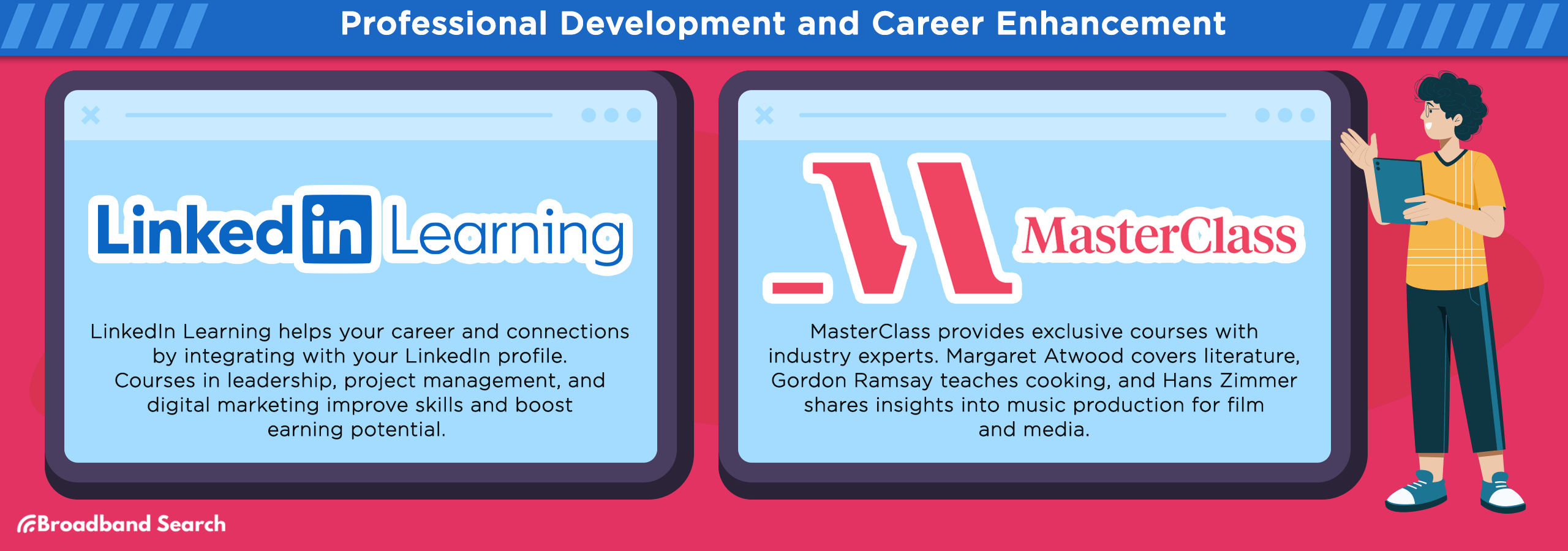
LinkedIn Learning
LinkedIn Learning is your gateway to career development and networking. It seamlessly integrates with your LinkedIn profile, allowing you to showcase your new skills and connect with professionals in your field. The most popular courses are as follows:
Leadership
LinkedIn Learning's leadership courses empower individuals to become effective leaders and managers. Topics range from team building to communication skills. In a recent survey, 87 percent of LinkedIn Learning users reported improved leadership skills contributing to their career growth.
Project Management
Project management is a cornerstone of successful businesses. LinkedIn Learning offers courses on project management methodologies, tools, and techniques. Acquiring project management skills can boost your earning potential, with certified project managers earning an average salary of $94,500, according to the US Bureau of Labor Statistics.
Digital Marketing
With the rise of the digital age, digital marketing skills are in high demand. LinkedIn Learning's digital marketing courses cover SEO, social media marketing, and content strategy. Professionals who acquire these skills can tap into a job market, as the digital marketing industry is projected to grow by 10 percent from 2021 to 2031.
MasterClass
MasterClass distinguishes itself by offering courses taught by renowned industry leaders, providing unparalleled access to their expertise. Here are a few example classes you might want to consider:
Writing by Margaret Atwood
Acclaimed author Margaret Atwood shares her insights into storytelling and the craft of writing. Her MasterClass immerses learners in the world of literature and creative writing, helping them refine their writing skills.
Cooking by Gordon Ramsay
World-renowned chef Gordon Ramsay invites learners into his kitchen, where they can master culinary techniques and elevate their cooking skills. Ramsay's MasterClass offers a unique opportunity to learn from a culinary legend, and it's a testament to the platform's caliber.
Music Production by Hans Zimmer
Award-winning composer Hans Zimmer offers a deep dive into the world of music production. With his guidance, aspiring musicians and composers gain a unique perspective on the art of creating music for film and media. Zimmer's MasterClass has garnered critical acclaim.
Academic and Research Resources
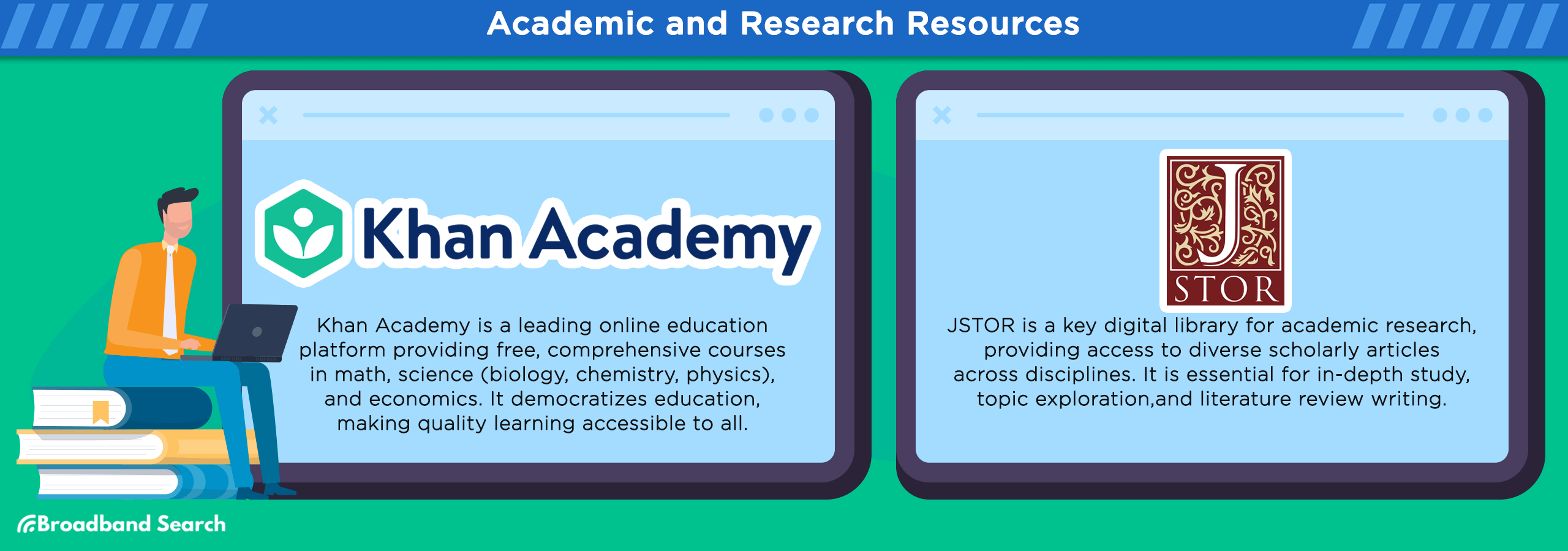
Khan Academy
Khan Academy stands as a master guide in the online education landscape, offering free and comprehensive resources suitable for learners of all ages. Its significance lies in democratizing education, making high-quality learning accessible to everyone, everywhere.
Math
Ranging from basic arithmetic to advanced calculus, Khan Academy's math courses are known for their clarity and depth. The interactive exercises in the "Algebra I" course, for example, help build a strong foundation, crucial for both academic and everyday problem-solving skills.
Science
The platform covers a wide array of scientific subjects, including biology, chemistry, and physics. The "High School Biology" course, featuring interactive content and real-world examples, is particularly popular among adult learners seeking to revisit or reinforce scientific concepts.
Economics
Khan Academy offers comprehensive courses in economics, including macroeconomics and microeconomics. These courses, such as "AP Macroeconomics," are designed to provide both theoretical knowledge and practical understanding, essential for both students and professionals interested in the field.
JSTOR
JSTOR is a digital library essential for anyone delving into academic research. Offering access to a wealth of academic journals and papers, it's an invaluable resource for in-depth study and scholarly exploration.
Academic Research
JSTOR is invaluable for conducting in-depth research, providing access to a plethora of scholarly articles across disciplines. A student researching environmental policies, for example, would find a rich array of relevant, peer-reviewed articles on JSTOR, aiding in the development of a well-informed thesis.
In-Depth Topic Exploration
For those delving deep into specific subjects, JSTOR offers comprehensive material. For example, someone studying Shakespeare's works can access a variety of critical essays and analyses, providing diverse perspectives and insights.
Writing Literature Reviews
Students and academics writing literature reviews find JSTOR particularly useful. Its vast archive of scholarly articles allows for a thorough examination of existing research, crucial for formulating well-informed, academically rigorous reviews.
Creative and Artistic Exploration
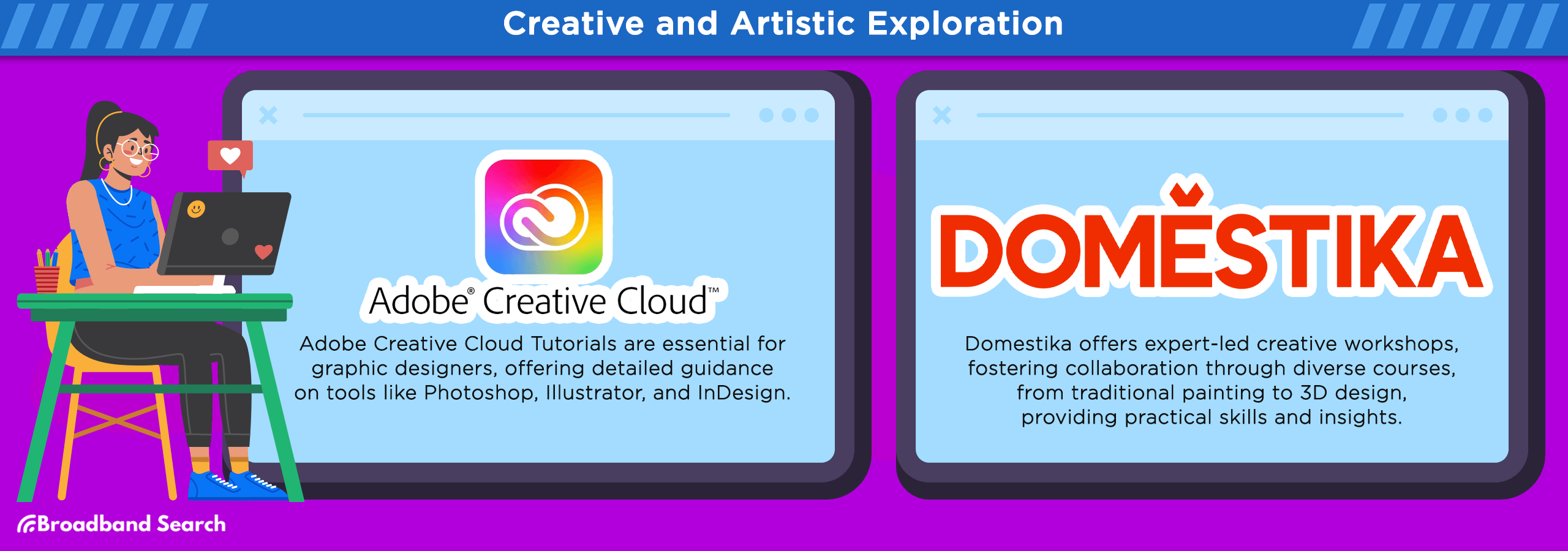
Adobe Creative Cloud Tutorials
Adobe Creative Cloud Tutorials are a goldmine for both aspiring and professional graphic designers, offering an in-depth understanding of essential design tools. These tutorials are critical for mastering the software that drives the modern design industry.
Photoshop Tutorials
Ideal for photo editing and graphic design, these tutorials cover everything from basic photo adjustments to advanced compositing. For example, a beginner can learn to manipulate images for digital marketing, a skill highly sought after in today's visually-driven online landscape.
Illustrator Tutorials
Focused on vector graphic design, these tutorials are perfect for creating logos, illustrations, and typography. They teach techniques like Bezier curves and layer management, essential for professionals working in branding or digital illustration.
InDesign Tutorials
These are aimed at layout design, teaching how to create professional-looking brochures, magazines, and eBooks. InDesign tutorials guide users in mastering layout grids and typography, skills crucial for those in publishing and advertising.
Domestika
Domestika emerges as a vibrant platform for those pursuing creative and artistic exploration, specializing in art, craft, and design. Its value lies in providing high-quality, niche-specific learning experiences guided by industry experts.
Workshops by Renowned Artists
These courses are led by industry professionals, offering insights into real-world creative processes. For instance, a workshop on digital illustration by a celebrated illustrator provides practical skills and industry knowledge, bridging the gap between amateur and professional artistry.
Community Projects
Learners can participate in projects, showcasing their work to a supportive community. This feature is particularly valuable for feedback and collaboration, like in a photography course where students can share and critique each other’s portfolios, enhancing learning through peer interaction.
Diverse Course Range
Domestika’s courses span from traditional painting to modern 3D design, catering to a wide spectrum of interests. A course on watercolor techniques, for example, appeals to traditional artists, while a course on 3D animation attracts those interested in digital media.
Financial Literacy and Management
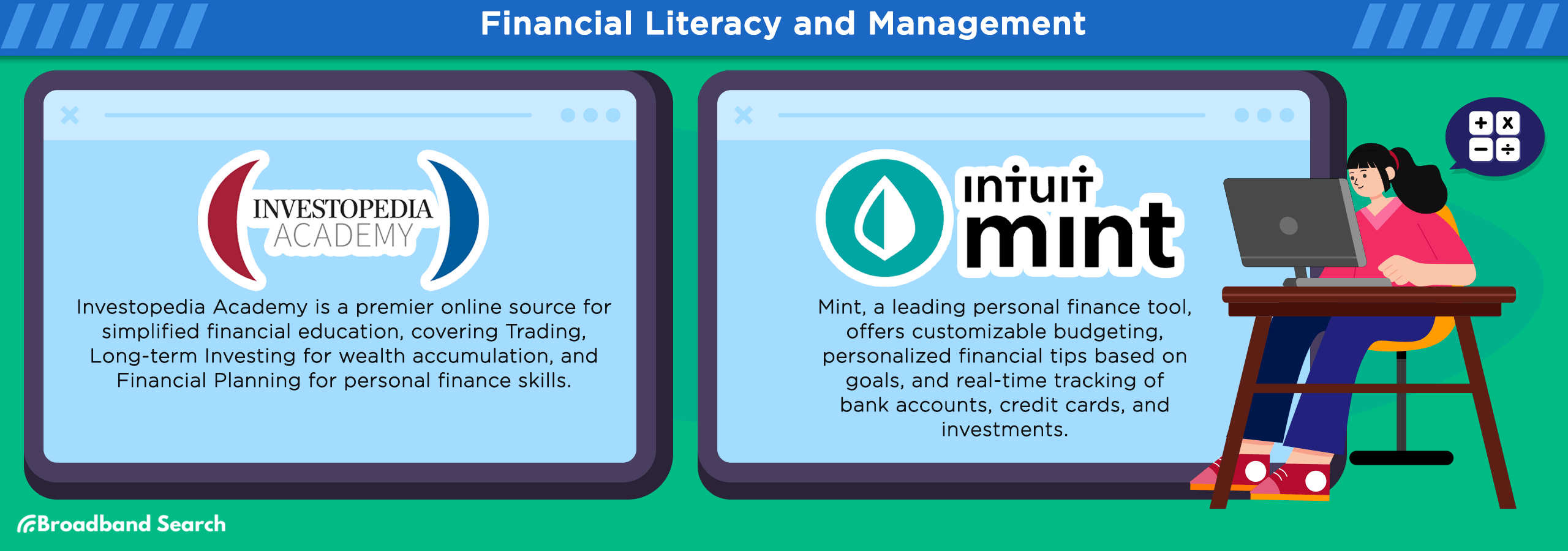
Investopedia Academy
Investopedia Academy stands out as a premier online resource for financial literacy and management. It demystifies complex financial concepts, making them accessible to everyone, which is crucial in today's economy, where financial knowledge is key to personal and professional success. Below are the top course types at Investopedia Academy:
Trading
These courses cover various aspects of trading, from basics to advanced strategies. A course like "Become a Day Trader" teaches effective trading techniques, risk management, and the psychology behind trading decisions, which is essential for navigating today's volatile markets.
Investing
Focused on long-term wealth building, these courses include stock market basics, portfolio management, and retirement planning. "Investing for Beginners," for instance, guides learners through the fundamentals of creating a diversified investment portfolio, a vital skill in an era of financial uncertainty.
Financial Planning
These courses are tailored for those seeking to manage personal finances or pursue a career in financial planning. A course like "Personal Finance" covers budgeting, saving, debt management, and retirement planning, providing essential skills for sound financial decision-making in various life stages.
Mint
Mint is a highly regarded tool for personal finance management, essential in today’s world where efficient budgeting and financial tracking are key to achieving financial stability and growth. Here are some of the best features that you can get on Mint:
Budgeting Tools
Mint’s budgeting features allow users to create customized budgets that track their spending. For example, users can set limits for different categories like groceries, entertainment, or utilities, helping them stay within their financial means and save more effectively.
Financial Tips
The platform offers personalized financial advice based on users' spending habits and financial goals. This includes tips on saving for retirement, reducing expenses, or improving credit scores, tailored to individual financial situations.
Real-Time Tracking
Mint provides real-time updates on users' financial status, including bank accounts, credit cards, and investments. This feature helps users monitor their financial health continuously, and make informed decisions, like adjusting spending habits based on current account balances.
Personal Development and Wellness
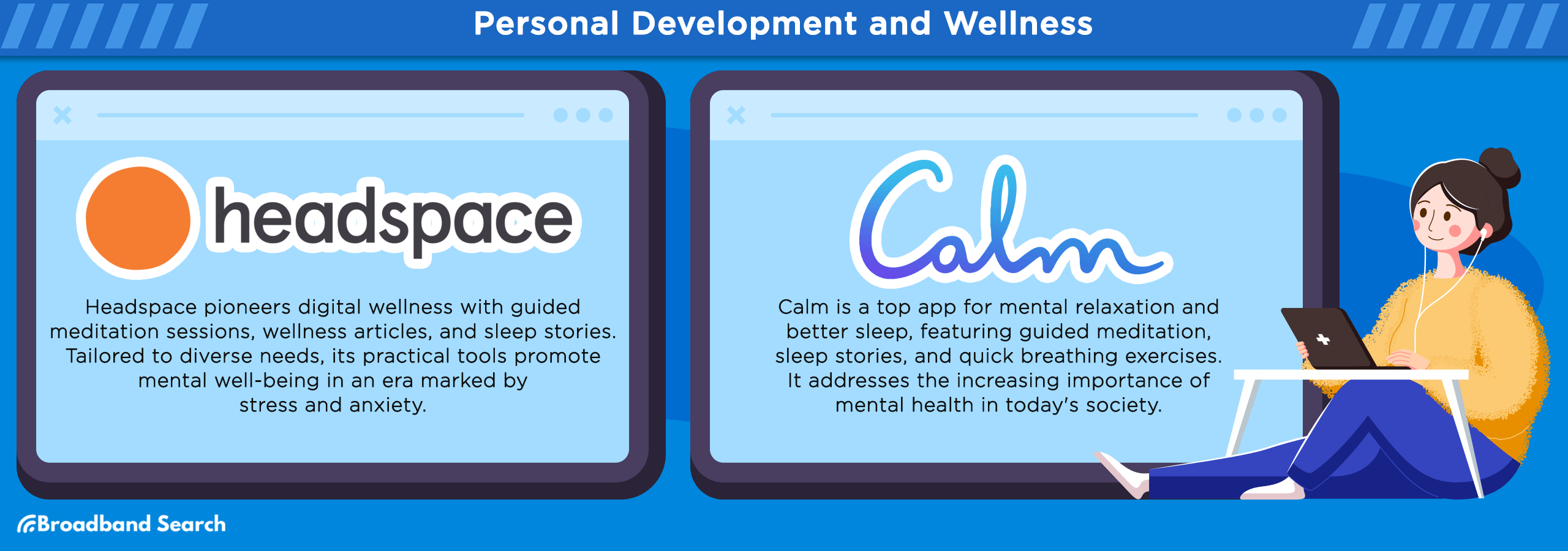
Headspace
Headspace is a pioneer in the digital wellness space, offering tools and resources to foster mental health through meditation. In an era of stress and anxiety, its role in promoting mindfulness and mental well-being is invaluable.
Guided Meditation Sessions
Headspace provides a variety of guided meditation sessions tailored to different needs, like stress reduction or improved sleep. These sessions, such as the popular "10-minute Daily Calm," offer practical techniques for relaxation and mindfulness, suitable for both beginners and experienced meditators.
Articles on Wellness
The platform offers informative articles covering various wellness topics, from managing anxiety to improving sleep quality. These resources, like the article "How to Handle Stress at Work," provide valuable insights and practical tips for everyday mental wellness.
Sleep Stories and Music
Headspace also includes sleep stories and calming music designed to help users achieve better sleep quality. Features like "Sleepcasts" offer soothing narratives and soundscapes, essential in today’s fast-paced world where quality sleep is often compromised.
Calm
Calm is a renowned app focusing on mental relaxation and sleep improvement, providing audio content designed to alleviate stress and enhance sleep quality. Its significance is paramount in a society where mental health is as crucial as physical health. Here are the top features of Calm:
Guided Meditation Sessions
Calm's meditation sessions cater to various needs, ranging from anxiety reduction to focus enhancement. For example, the "7 Days of Calm" program offers a structured approach to meditation, ideal for beginners looking to incorporate mindfulness into their daily routine.
Sleep Stories
These are narrative-driven audio experiences that aid in falling asleep. With stories like "The Lavender Valley," narrated by soothing voices, Calm transforms bedtime into a peaceful ritual, essential in managing sleep disorders that affect a large portion of the adult population.
Breathing Exercises
The app includes guided breathing exercises, a simple yet powerful tool for managing stress and anxiety. Exercises like "Breathe Bubble" are designed to be quick and effective, ideal for busy lifestyles where finding time for relaxation can be challenging.
Culinary Skills and Healthy Eating
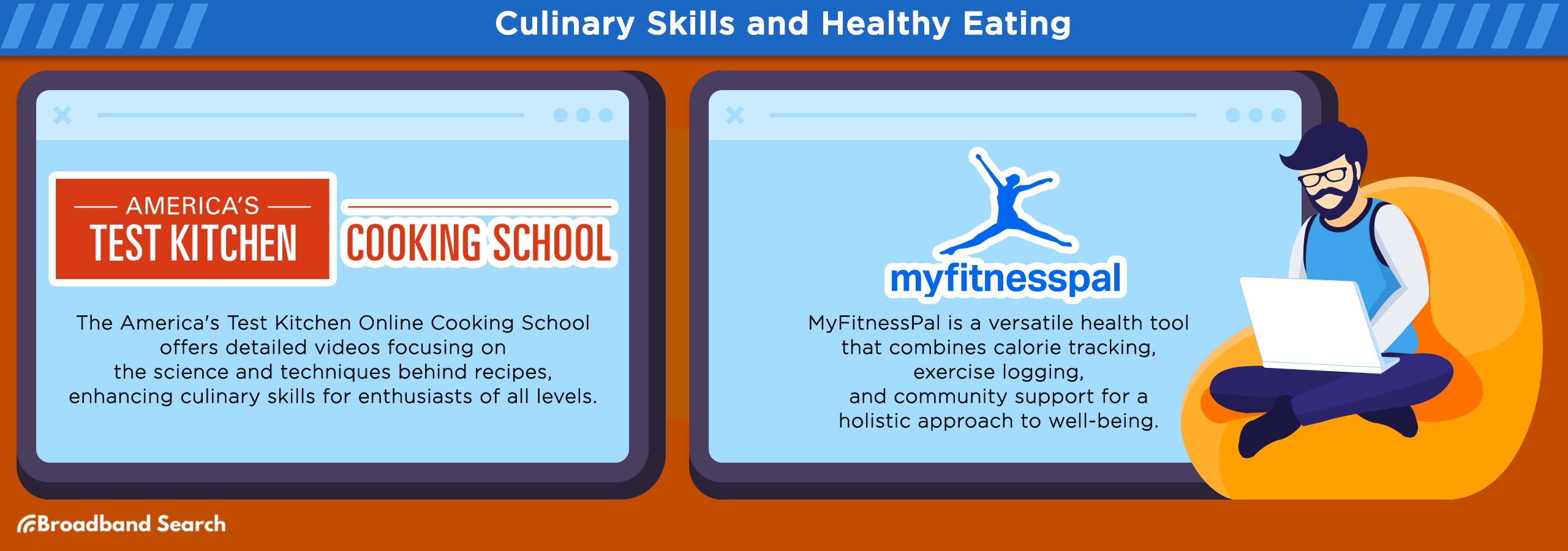
America's Test Kitchen Online Cooking School
America's Test Kitchen Online Cooking School is a treasure trove for culinary enthusiasts of all levels. It excels in teaching not just recipes, but the science and techniques behind them, making cooking a more intuitive and enjoyable experience. Let's explore its top special features.
Step-by-Step Instructional Videos
The online school provides detailed videos demonstrating cooking techniques and recipes. For instance, a video on knife skills not only shows how to chop, dice, and mince but also explains why each technique is used.
Recipe Mastery
Each course focuses on mastering specific recipes, ensuring learners follow instructions and understand the science behind them. A baking course, for example, might delve into the intricacies of yeast breads, teaching the reasons behind each step.
Skill-Building Courses
These courses focus on building fundamental cooking skills. Whether it’s knife skills, sauce-making, or baking basics, learners gain confidence in the kitchen, enabling them to experiment and create dishes beyond the guided recipes.
MyFitnessPal
MyFitnessPal is a pivotal tool in the journey towards nutrition and physical health. It stands out for its comprehensive approach to health management, blending calorie tracking with exercise logging and community support, which is crucial in today's health-conscious world. Top features include:
Calorie Tracking
This feature allows users to log their daily food intake, offering a detailed breakdown of calories and nutrients. For instance, after entering a meal, the app calculates the calorie count and nutritional information, helping users stay on track with their dietary goals.
Exercise Logging
MyFitnessPal also enables users to record their physical activities. Whether it's a brisk walk or a gym session, the app estimates the number of calories burned, integrating this data with nutritional intake for a holistic view of health.
Community Support
The app provides a platform for users to connect with others on similar health journeys. Features like shared goals or challenges, such as a 30-day step challenge, encourage motivation and accountability.
The Bottomline
Education has never been more dynamic. These platforms offer unparalleled flexibility, allowing you to tailor learning to your schedule and interests. Whether honing a professional skill or nurturing personal wellness, the digital world is your oyster for knowledge and growth.
Embrace these tools as your allies in lifelong learning. Integrating them into your daily routine can be as simple as listening to a podcast during your commute or practicing a new recipe on the weekend. Remember, each step, no matter how small, contributes to your personal and professional enrichment journey. Keep exploring, and keep learning!
FAQ
Are there free options available for adult learning online?
Numerous platforms offer free adult learning options. Coursera, Khan Academy, and edX provide courses from universities globally for free, covering various subjects. While some courses are free, certifications may require a fee, offering relatively budget-friendly learning methods.
What technological requirements are needed for online learning?
The primary technological requirements for online learning include a reliable computer or tablet, a stable internet connection, and essential software like a web browser and a document reader.
What are the accreditation and recognition of online courses and certificates?
Regarding accreditation, many online courses and certificates are recognized in the professional realm. Institutions like Coursera and edX collaborate with universities, providing courses that often carry weight in the job market and for academic advancement.
How do interactive components (like forums, webinars) enhance online learning?
Interactive components like forums and webinars significantly enhance online learning. They foster community, encourage collaboration, and provide real-time feedback, making learning more engaging and effective.
What support services are available for online learners?
Online learners typically have access to a range of support services. This includes technical assistance for navigating the platform, academic advising for course selection, and sometimes career counseling, helping learners apply their new skills in the professional world.

